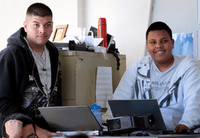Customizing Without Computers
“Customizing Without Computers” by Chris Sturgis was as originally published at Connected by 25 the blog of the Youth Transition Funders Group (YTFG) hosted by Chris Sturgis.
—

I saw the future of high schools yesterday. It wasn’t about cool digital aps, laptops, or talking to other young people on the other side of the world. It was re-engineering schooling around young people and their lives. Only in its second year,ACE Leadership High School, a charter school in Albuquerque, has the key to to unlocking our young people’s hearts and minds.
Michael, a 10th grader made the point very clear, “In regular schools, you either make it or you don’t. If you fit into their style, you’ll succeed. If you don’t, you fail. ACE molds itself around us.” In the policy world, we call that customization. (Click here for more on what students value at ACE).
I have been listening to Tony Monfiletto, a co-founder of ACE, talk about the school for awhile. Each time I went further and further into a discomfort zone with a growing feeling that I wasn’t really understanding what he was telling me. I finally decided that I had to go see for myself. And I’m glad I did. Below are some of the major designs elements that ACE is weaving together into one of those schools that any student would be lucky to go to.
Accept Students at All Stages of their High School Careers: ACE serves all young people that we adults like to package as “at-risk”. Some of the students enter directly from 8th grade, some after failing courses in 9th grade at a different high school, some are re-engaging in school after months or even years of being a “dropout”. At this time, 80% of the students are overage, under-credited.
This is an enormous breakthrough. Current practice has either four year high schools or alternative schools for students that need recuperation or re-engagement. Most charter high schools don’t even enroll students after 10th grade. ACE wants them. They’ve designed the school to enroll students at all different stages of “readiness”. ACE is designed around where students are, not where the school is in terms of linear factory-model education system.
Positive Youth Development is the Means to Achievement: At the end of my visit, Tony and Rafe Martinez, the Director of Student Support, reflected on the culture of the school. Tony explained, “We didn’t draw on PYD because we love kids. It’s the way to get at achievement.” Most of the students enter ACE with a bucket full of harsh life experiences, many of them from their previous school experiences. PYD is interwoven into every part of the school.
- Every inch of the school is designed to be meaningful to students. There is nothing you have to do “just because”.
- An expansive “advisory” model is a major part of the day, 90 minutes in the morning and a wrap-up at the end of the day. It includes a focus on a healthy life, workout time, emotional check-in and time for college and career development.
- ACE uses a “coach” model in which the adults expect the very best from the students balanced with open-hearted listening so that the students feel safe to tell them about what is going on in their lives. Staff are hired for their ability to engage with young people, the majority of which are young men, as well as their expertise in teaching.
- Relationships are at the heart of the school. Rafe explained that the mantra is “bonding by doing”.
- Emotional upheaval is assumed to be part of life with teenagers. One student said that his problems with anxiety had caused him trouble at previous schools. But at ACE he is allowed to take a break from the classroom when anxiety starts to bubble at too high a level. Over time he is having less problems managing it and can stay in class more. During the reflection, Tony explained with the laughter of someone who really loves teenagers, “We believe that we can never out-escalate a young person, so why try.” About one fifth of students need intensive support at any given time. They are “staffed” by social workers, counselors and academic faculty to address the individual issues. No one gives up on the students. A student explained with a big smile on her face that it is nearly impossible to be expelled. They are a family committed to each other’s growth and success.
Jobs are the Means to Achievement: With equal intensity, career development is integrated into every part of the school. ACE stands for Architecture, Construction and Engineering. Students are promised by teachers on the first day of school that if they stay in school they will be ready for college or an apprenticeship. College isn’t the outcome, it’s a step towards a job.
- On the walls in the “open space”(designed for morning gatherings of advisory, working out, projects, meals), are four values borrowed from industry that powerfully shape the school culture:
- Build your reputation — Construye tu reputacion
- We’re a family — Somos una familia
- Protect OUR own — Protejer lo nuestro
- Do the right thing — Haz lo que es correcto
- The partnerships with industry are extraordinarily deep. Industry partners work side by side to create real-world project-based learning that incorporates academic standards. For example, ACE developed a project in partnership with Los Alamos National Bank focusing on site selection. Tasks include surveying to learn trigonometry, soil testing to learn composition and density, and zoning to explore local government.
- ACE understands that students don’t always follow a linear path of high school, then college, then find a job. Jobs are considered a vital piece of the puzzle to keep students in school. The staff worked hard to help one of the younger students that was on the verging of dropping out find a job so that they could provide the necessary financial support to their family. Jobs are motivating and sometimes they are a necessity.
Mastery: ACE focuses on mastery rather than seat-time. This plays an important function in serving students entering with a wide range and gaps in their academic skills. Mastery is also aligned with the emphasis on learning by doing or project-based learning. Initial indicators are showing that this is working with first year students increasing proficiency in reading skills from 33% to 70%.
- New Mexico state standards and 21st century workplace skills (communication, collaboration and client-driven) drive the curriculum.
- Emphasis is on clear targets with lots of ways of helping the students get there (differentiation) and individualized use of “little checks” (formative assessment).
- More time for learning when it is needed. The school year is structured so that students have three, three-week breaks. During the breaks, those students that need more time come to school for very individualized work.
- Students can choose to go to school in evening rather than the daytime. Approximately 1/3 of the students choose to go to school in the evening as it is more accelerated to help older students or because they need to work during the day.
- Eighty percent of the students speak or understand Spanish. ACE focuses on bilingualism, seeing strong Spanish skills as an asset.
I’ll be writing about ACE a lot more in the coming weeks as I think there are several elements that can inform our work to better support young people in their transition to adulthood. First, the approach recognizes that you can’t break off cognitive skills from emotional IQ and life circumstances. I increasingly believe that policy is just spinning in circles until we respond to students in a holistic way. Second, ACE is a beautiful example of reweaving the social contract in our country between communities, employers, and young people. Third, New Mexico is a ‘majority-minority’ state that offers us invaluable insights into how to integrate the assets and values of different cultures into the core of our education system.








0 Comments
Leave a Comment
Your email address will not be published. All fields are required.